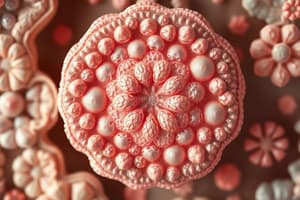Podcast
Questions and Answers
Which of the following is the correct order, from smallest to largest, in terms of biological organization?
Which of the following is the correct order, from smallest to largest, in terms of biological organization?
- Organs, tissues, cells
- Tissues, organs, cells
- Cells, tissues, organs (correct)
- Tissues, cells, organs
Nervous tissue is characterized by tightly packed cells that primarily function to cover and protect organs.
Nervous tissue is characterized by tightly packed cells that primarily function to cover and protect organs.
False (B)
How does the arrangement of cells in connective tissue contribute to its function?
How does the arrangement of cells in connective tissue contribute to its function?
The widely spaced cells in connective tissue, surrounded by a matrix, allow it to connect other tissue types and provide structural support.
To calculate the total magnification of a microscope, one must multiply the magnification of the ocular lens by the magnification of the ______ lens.
To calculate the total magnification of a microscope, one must multiply the magnification of the ocular lens by the magnification of the ______ lens.
Match the following tissue types with their primary functions:
Match the following tissue types with their primary functions:
Flashcards
Tissue Types
Tissue Types
Four main types of tissues are epithelial, connective, muscular, and nervous.
Epithelial Tissue
Epithelial Tissue
Cells are tightly packed; it covers surfaces and lines organs to protect and absorb.
Connective Tissue
Connective Tissue
Widely spaced cells surrounded by a matrix that supports and connects other tissues.
Muscular Tissue
Muscular Tissue
Signup and view all the flashcards
Nervous Tissue
Nervous Tissue
Signup and view all the flashcards
Characteristics and functions of muscular tissue
Characteristics and functions of muscular tissue
Signup and view all the flashcards
Characteristics and functions of muscular tissue.
Characteristics and functions of muscular tissue.
Signup and view all the flashcards
Study Notes
Cells and Tissues
- All organisms are composed of cells working together for structure and function.
- Cells form tissues.
Tissue Types
- Tissues are groups of similar cells working together.
- Four main types:
1. Epithelial Tissue
- Structure: Tightly packed cells.
- Function: Covers body surfaces and lines organs, offering protection and absorption.
- Examples: Skin, intestine lining
2. Connective Tissue
- Structure: Widely spaced cells surrounded by a matrix.
- Function: Connects and supports other tissues, providing structure.
- Examples: Blood, bone, cartilage
3. Muscular Tissue
- Structure: Long, thin, closely associated muscle cells.
- Function: Coordinated movement through intercellular communication.
- Examples: Hamstring muscle, shoulder muscle
4. Nervous Tissue
- Structure: Neurons (star-shaped nerve cells).
- Function: Sends nerve impulses to control muscles, organs, and glands.
- Examples: Brain, spinal cord, nerves
Viewing Cells and Tissues
- Microscopes are required to view cells and tissues.
- Microscopes use a series of lenses to magnify.
Magnification
- Ocular Lens: The lens you look into.
- Objective Lens: The lens nearest the specimen.
- Total Magnification: Calculated by multiplying ocular magnification by objective magnification.
Characteristics and Functions of Muscular Tissue
- Skeletal Muscle: Voluntary, moves bones.
- Cardiac Muscle: Involuntary, pumps the heart.
- Smooth Muscle: Involuntary, controls organs.
Epithelial vs. Connective Tissue
- Epithelial Tissue: Cells are tightly packed, covers surfaces, protects, and absorbs.
- Connective Tissue: Cells are spaced apart, supports and connects tissues, providing structure and storing energy.
Studying That Suits You
Use AI to generate personalized quizzes and flashcards to suit your learning preferences.




